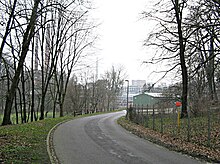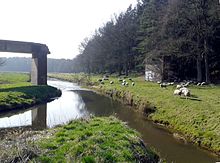Bomlitz (river)
| Bomlitz | ||
| Data | ||
| location | Lower Saxony , Germany | |
| River system | Weser | |
| Drain over | Böhme → Aller → Weser → North Sea | |
| source |
Stichter See near Neuenkirchen (Lüneburg Heath) 53 ° 0 ′ 32 ″ N , 9 ° 41 ′ 52 ″ E |
|
| Source height | approx. 76 m above sea level NN | |
| muzzle | near Uetzingen ( Walsrode ) in the Böhme coordinates: 52 ° 53 '2 " N , 9 ° 38' 5" E 52 ° 53 '2 " N , 9 ° 38' 5" E |
|
| Mouth height | approx. 33 m above sea level NN | |
| Height difference | approx. 43 m | |
| Bottom slope | approx. 2 ‰ | |
| length | 21.7 km | |
| Catchment area | 71 km² | |
| Discharge at the Westerharl A Eo gauge : 60.8 km²
|
NNQ MNQ 1990-2002 MQ 1990-2002 Mq 1990-2002 MHQ 1990-2002 HHQ |
153 l / s 220 l / s 440 l / s 7.2 l / (s km²) 3.5 m³ / s 6.39 m³ / s |
| Discharge at the mouth of the A Eo : 71 km² |
MQ Mq |
530 l / s 7.5 l / (s km²) |
| Left tributaries | Meinerner Moorgraben, Riesbeek | |
| Flowing lakes | Stichting lake | |
| Small towns | Soltau (district Woltem) | |
| Communities | Walsrode | |
| Residents in the catchment area | about 6000 | |
The Bomlitz is a right, almost 22 km long tributary of the Böhme in the Heidekreis district in Lower Saxony .
Surname
The Bomlitz is called Bommelse in dialect , from originally Bamlina meaning small tree river as the main tributary of the Böhme , originally Bama , Bumen meaning tree river . The current name is derived from the place Bomlitz , whose name is derived from the location at the right-angled Talknick, the Bommel-Etz or Bommel-Letzel .
Course and characteristics
The Bomlitz rises between Neuenkirchen and Soltau in the Stichter See , which was created during the last glacial period as Schlatt (in this area: Flatt ), now largely silted up, but around 1900 with a good six hectares it was still the largest natural lake in the Lüneburg Heath (small natural beach).
As it progresses through the almost uninhabited Riensheide, the ditch-like brook repeatedly loses water into the permeable subsoil and to the groundwater flow , which is directed here to the Hahnenbach, which flows 20 meters deeper to the north .


To the south of the crossing American line , the gradually deepening Bomlitztal in the area of the villages of Frielingen, Woltem, Bommelsen and Kroge (city of Walsrode) forms a textbook-like typical example of the former cultural landscape in the natural area of the Fallingbostel clay plates. A series of individual farms and hamlets close to the banks are located on cross paths between the country roads that accompany the valley floor on both sides. The courtyards, some of which are well-preserved and include historical staircases , are embedded in small, old deciduous forests, followed by arable land and grassland as the distance from the courtyard increases. In the past, the fields had been cultivated into more productive ash fields by pests from the heather on the edge . The often boggy heather areas are largely forested today.
The valley narrows above Bomlitz . There the Bomlitz meanders in a near-natural alluvial forest through former damming areas that were created for the former Bommels paper mill (from 1691) and the later powder factories (from 1815). It then crosses the old Bomlitz estate area and then, over a kilometer and a half, the Dow Wolff Cellulosics plant , one of the largest and oldest locations of the chemical industry in Lower Saxony. The plant area is structured by wooded steep slopes. The extensive settlement area of Bomlitz stretches up the left slope here, similar to the settlement area of Benefeld a little below on the right slope .
Below the bridge of the Wolff works railway , the gradient increases, and the stream crosses the former restricted area and today's recreational area of the Lohheide. Some of the remains of the Eibia ammunition factory, which operated between 1938 and 1945, are still recognizable, some as heaped-up rubble fields, and some as walls and embankments that integrated the more than 250 buildings into the turbulent terrain. Here the Bomlitz forms a well-developed valley meander with steep slopes up to 20 meters high, which is unusual for the north German lowlands . The former narrow valley meadows have given way to an alder forest , apart from a few wet remains . The stream has been canalized since around 1850, but has been renatured in places. In the triangle of the places Walsrode , Bad Fallingbostel and Bomlitz the brook flows into the Böhme, overlooked by the remains of a partly blown railway bridge.
Catchment area and natural area
The natural water flow of the Bomlitz, averaging half a cubic meter per second, is unusually low for the western heath with a catchment area of over 70 km². The main cause is the underground water loss to the northwest to the lower lying Wümmegeest.
In its course, the Bomlitztal, which is almost straight in the upper reaches, was mapped out especially during the penultimate glacial period of the current ice age , the Saale glacial period . The valley follows various shallow furrows left by the inland ice and its meltwater. It turns nurmehr the residue of an earlier Talzuges represents. Its headwaters stands today Gilmerdinger Bach after which later Hahnenbach and thus Wümme toward distracted has been. To the south, the Bomlitztal continues in a boggy valley that separates Walsrode (core town) from Honerdingen and Düshorn . It was cut off by the Bohemian knee that was created later (at the end of the older Drenthe stage from the Cold Age of the Saale , around 200,000 years ago) .
The lower Bomlitztal shows the narrow valley floors typical of the Böhmeknie particularly pronounced. Here, the valley largely cuts through the loose material that was deposited and relocated by the inland ice of the Saale Glacial Age and its meltwater: The several meters thick ground moraine of the Drenthe I stadium is overlaid by the refill sands of the receding ice front and the refill sands of the approaching ice front of the Drenthe II stadials. Its thin ground moraine, rich in coarse debris and boulders, make up today's clayey plateaus. The Drenthe I ground moraine shows that the Bomlitztal in the Lohheide area had a common forerunner with the Warnau valley to the west . Above this ground moraine, numerous source channels arise from the pouring sands, which flow into the Bomlitz after a short run and contribute to the agitated topography of the slopes.
Water quality
Above Bomlitz the Bomlitz was and is lightly to moderately polluted. Until the construction of the large sewage treatment plant with 210,000 population equivalents operated jointly by the Wolff company (today: Industriepark Walsrode ) and the former municipality of Bomlitz, however, the Bomlitz below the Wolff plant was one of the most heavily polluted rivers in Lower Saxony. Three small mechanical sewage treatment plants could not prevent the Bomlitz from carrying noticeably warmed, cloudy, green-gray water, which only gave room for bacterial life forms and whose strong chemical smell made it difficult to stay on the bank. In the decades before 1945, a changing acid load led to fish deaths in the Böhme several times, and in some cases also in the Aller .
Until the construction of the large sewage treatment plant, it was marked in the water quality maps with the highest pollution level. Since then, their water quality has been class II-III in terms of oxygen content, and less favorable according to other parameters. Smell and appearance are generally inconspicuous, so that their charming narrow valley is now heavily frequented by those seeking relaxation.
literature
- Geoscientific map of the natural space potential of Lower Saxony and Bremen 1: 200,000, CC 3118, Part 4 - Groundwater Basics, Hanover, 1981
- Topographic map 1: 25,000, sheets 2924 Neuenkirchen , 3024 Dorfmark , 3123 Walsrode and 3124 Fallingbostel (Ed .: State survey and geographic base information Lower Saxony), Hanover ISBN 3-89435-220-5
- Helge Matthiesen : Secret Reich Matter Eibia. Walsrode 1987
- Olaf Mußmann: Self-organization and chaos theory in historical science: The example of the industrial and armaments village Bomlitz 1680-1930. Leipzig, 1998
- Hans-Heinrich Seedorf: Walsrode, Fallingbostel and the central Böhmetal in the year 1778. Explanations for sheet 89 Walsrode of the Electoral Hanover land survey of the 18th century (sales: land surveying and geographic base information Lower Saxony), Hanover, 1986
- Hans Stuhlmacher: Home book of the Fallingbostel district. Magdeburg 1935
- Wolfgang Wasser: Traces of the history of the earth in the valleys of the Middle Bohemia, Bomlitz and Warnau , flashback 6 (publisher: Stiftung Geschichtshaus Bomlitz), Bomlitz 2016
Individual evidence
- ↑ a b Measurement in TK 25
- ↑ Westerharl gauge value , increased by the drainage of the remaining catchment area (10.2 km² with 9 l / s km², derived from the value of the intermediate catchment area of the Brock and Hollige an der Böhme and Westerharl an der Bomlitz gauges); without the water taken from the Böhme, which is returned via the Bomlitz sewage treatment plant
- ↑ Information on the water quality of the northern Bohemian ( page no longer available , search in web archives ) Info: The link was automatically marked as defective. Please check the link according to the instructions and then remove this notice.

